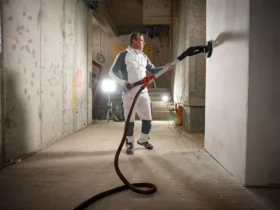Many people wonder how much moisture should be in their house when they use air conditioning. An important fact is that the perfect amount of humidity falls between 30 to 50 percent.
This article will show you how to keep your indoor air at this ideal level, making your home more comfortable and healthy. Continue reading for easy tips and tricks.
What is Humidity?
Humidity is all about the amount of water vapor in the air. Too much moisture can make your home feel stuffy and cause mold to grow.
Humidity means the moisture level in the air. It affects how warm or cool our homes feel. Too much moisture can make it feel hotter than it really is. Homes need a good balance of humidity for comfort and health.
Air conditioners help control indoor humidity by taking heat and water vapor out of the air. This process keeps our homes from feeling too sticky or damp. Without proper humidity levels, mold and window condensation can become problems.
Balanced humidity makes a house feel more comfortable.
Read Also:- Family-Friendly
How high humidity levels affect homeowners
Moving from the basics of humidity, we see how it really impacts those living in a house. High humidity inside your home can lead to problems like mold growth and wood rot. These issues not only damage your home but can also harm your health.
Excess moisture makes a perfect home for mold, which harms the air you breathe. Plus, items made of wood in your house may start to rot if there’s too much water in the air.
This dampness affects more than just the structure of homes and personal health; it challenges air conditioning systems too. When there’s a lot of moisture, air conditioners have to work harder to keep things cool and comfortable.
This extra effort can lead to more breakdowns and shorter lives for these cooling units. Also, when humidity pairs with high temperatures outside, it becomes tougher for our bodies to cool down efficiently—raising the risk of heat-related illnesses like heat stroke.
The Role of Air Conditioning in Humidity Control
Air conditioning doesn’t just cool your home. It also helps control moisture by pulling water from the air inside.

Does AC control humidity?
Yes, AC units can control humidity to some extent. They work by pulling hot air inside your home and cooling it down. As they cool the air, they also remove moisture. This process reduces the amount of water vapor in your home, which lowers humidity levels.
A well-set-up HVAC system keeps indoor humidity under 50% during warm periods without needing an extra dehumidifier.
A properly set up air conditioning system should maintain humidity levels below 50% during cooling hours without the need for a dehumidifier.
However, conventional ACs and heat pumps don’t adjust temperature and moisture independently. If your house feels damp or you notice condensation on windows, it might mean the AC isn’t effectively reducing humidity on its own.
In such cases, using a standalone dehumidifying device can help keep your space comfortable and protect against mold growth.
The impact of high humidity on air conditioning systems
High humidity makes air conditioning systems work harder. This happens because the system has to remove not just heat, but also moisture from the air. As the moisture level goes up, so does the effort needed by the AC to cool down a room.
This leads to more energy use and higher bills for homeowners.
Air conditioners might struggle with high humidity because they’re designed to sense temperature, not how much moisture is in the air. If an AC unit is too big, it can’t manage humidity well.
This causes discomfort inside homes and may harm indoor air quality. Keeping these systems well-maintained helps control both temperature and humidity levels effectively.
Ideal Humidity Levels in a Home
Finding the right amount of moisture in your home is key. A hygrometer helps you check this so you can stay comfortable and healthy.
What percentage of humidity should be in the home?
The best relative humidity in your home is between 40% and 60%. This level stops mold from growing and spreading. Most experts say having humidity from 30% to 60% is okay for where you live.
If you have air conditioning, aim to keep humidity between 45% and 55%. The Environmental Protection Agency (EPA) also says it’s good to keep indoor humidity under 50%.
High or low humidity can hurt your health and make you uncomfortable. It can cause stuffy air or dry skin. Using tools like hygrometers helps check the moisture in your home. Next, let’s look at how unsuitable humidity affects our wellbeing and comfort.
How unsuitable humidity levels can affect health and comfort
Knowing the right humidity level for your home leads to the next important topic: how wrong humidity levels can harm health and comfort. Too much moisture makes your house feel hot and sticky.
This can cause mold and decay in walls and floors, which are harmful to breathe in. Low humidity dries out skin and nasal passages, making it hard to stay comfortable.
Rooms get too warm or too cold when humidity isn’t balanced, ruining sleep quality. Dehumidifiers help remove excess moisture, while humidifiers add water into the air when it’s too dry.
Keeping an eye on these levels ensures everyone in the home sleeps better and feels more at ease during the day.
How to Decrease Humidity in Your Home
To keep your home comfortable, you can cut down on moisture. Adding attic insulation and setting up exhaust fans can help a lot.

Managing humidity in your home keeps you comfortable and protects your house. Here are some easy, natural strategies to do just that.
- Use fans to increase air movement. Placing fans strategically around your house helps move the air and reduces moisture levels. This step is especially helpful in areas like the kitchen or bathroom where water vapor is common.
- Open windows when the weather is nice. Letting fresh air into your home can help push out moist, stale air, balancing indoor humidity.
- Move furniture away from walls. This allows air to circulate freely around the room, preventing moisture from becoming trapped between furniture and walls.
- Grow houseplants. NASA research shows that plants not only balance indoor humidity but also purify the air.
- Run exhaust fans in bathrooms and kitchens. These fans pull moist air out of your home when you’re cooking or after a shower, reducing overall humidity.
- Hang clothes outside to dry instead of using a tumble dryer inside. Air – drying clothes outdoors prevents extra moisture from raising indoor humidity levels.
- Use a dehumidifier in very damp areas like basements or large living spaces to remove excess moisture directly from the air.
- Install attic insulation and radiant barriers; they help maintain your home’s temperature and reduce the need for air conditioning, which can affect indoor humidity levels.
- Fix leaks promptly in roofs, pipes, and faucets to prevent excess water from entering your home and increasing humidity levels.
- Make sure your house has good airflow by checking vents and ducts are not blocked.This ensures moist air doesn’t get trapped inside rooms or crawl spaces.
Use of dehumidifiers and HVAC services
Dehumidifiers play a big part in keeping your home’s air just right, especially when paired with your air conditioning system. HVAC services make sure everything works together to keep you comfortable. Here’s how they help:
- Dehumidifiers pull moisture from the air. This makes your home feel cooler and more comfortable. They work well in areas where dampness collects, like basements.
- A whole – home dehumidifier works with your cooling system to keep humidity levels perfect. It stops mold from growing by keeping the air dry.
- Running a dehumidifier with your AC doesn’t lessen the moisture removal effect. Both devices can work at the same time to improve air quality in your house.
- HVAC technicians can tune up your systems to control humidity better. They adjust settings on your cooling unit and dehumidifier for optimal performance.
- Air conditioners remove some moisture as they cool, but they might not handle very damp conditions well on their own. Adding a dehumidifier ensures comfort even on muggy days.
- Regular maintenance from HVAC services keeps your systems running smoothly. This helps manage both temperature and moistness indoors, preventing issues like heatstroke or water damage to building materials.
- Technicians can install vents and fans, like range hoods over cooktops or exhaust fans in bathrooms, to reduce humidity sources directly at the source.
- Upgrading to an HVAC unit with a higher Seasonal Energy Efficiency Ratio (SEER) can improve temperature regulation while using less energy, helping with moisture control too.
- Professionals seal leaks around doors and windows to stop humid outdoor air from getting in. This process is known as reducing air infiltration which also saves on cooling costs.
- HVAC services often recommend solutions specific to your home’s needs, considering factors like climate, house size, and lifestyle habits for tailored humidity control.
Need a professional air conditioning service in port charlotte? Here is the air conditioning company that we recommend:
Company details:
Name: Chillia Air Conditioning
Address: 22107 ELMIRABLVD, PORT CHAR LOTTE, FL 33952, USA
Phone Number: (941) 699-2006
Website: https://airconditionportcharlotte.com/
Read Also:- openhouseperth.net insurance
Conclusion
Keeping humidity right keeps a house comfortable and healthy. Air conditioning helps manage moisture inside, making sure it’s not too high or low. Aim for humidity between 30 to 50 percent for the best feel and health at home.
Tools like hygrometers help check moisture levels, ensuring they stay in the safe zone. Making small changes can prevent big problems, keeping homes cozy and safe from mold or dry air issues.
FAQs
1. What is the best humidity level for a house with air conditioning?
The best humidity level in a house with air conditioning is between 30% and 50% relative humidity (RH). This range helps keep your home comfortable and prevents problems caused by too much moisture.
2. How does air conditioning affect indoor humidity?
Air conditioning lowers indoor humidity by cooling the air, which makes water vapor condense into liquid water. This process removes moisture from the air, making your home less humid.
3. Can high efficiency AC systems manage humidity better?
Yes, higher SEER (Seasonal Energy Efficiency Ratio) HVAC systems are better at managing both temperature and humidity levels inside your home because they can run longer at lower costs, pulling more moisture from the air.
4. Why do some rooms feel more humid even with AC on?
Some rooms might feel more humid due to poor airflow or leaks that let in warm outside air. Using exhaust fans in kitchens and bathrooms can help remove extra moisture from these areas.
5. What happens if my home’s humidity is too low or too high?
If your home’s humidity is too low, you might experience dry skin and irritation in your respiratory system. If it’s too high, it can make your house feel stuffy and support mold growth. Keeping an eye on dew points through psychrometrics can help balance out these extremes.














Leave a Reply